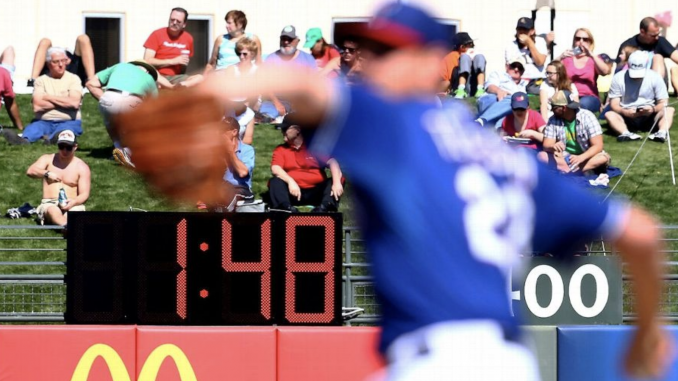
Back in February, Major League Baseball (MLB) Commissioner, Rob Manfred, spoke at a conference regarding players’ and fans’ concerns about the history and traditions of the game. “Our guiding star in thinking about changes to the game has always been our fans. ‘What do our fans want to see on the field?’” Through countless thorough research, the MLB concluded that three changes needed to be made: the pace needs to be faster, the fans want more competitive action, more balls in play and higher stakes, and last but not least, fans want to see the players test their athleticism. What are these significant rules changes you might be asking? They are a pitch clock timer, limits on a defensive shift and expanding the base sizes. According to ESPN, the league’s competition committee, composed of six ownership-level representatives, four players and one umpire voted to implement these changes in September before the 2023 Spring Training. The vote was not unanimous as player representatives voted no on the shift and pitch-clock portions of changes.
These rule changes are nothing new to the Triple-A and Minor Leagues as they have been tested and refined for years to suit every player’s style. “Each of these rules has been tested in approximately 8,000 Minor League games dating back to last season,” stated Manfred. “[This] is equivalent to 3.5 full Major League seasons.”
“The game is constantly changing, and the best version of baseball has meant different things to different people over time. We all fell in love with the game in different eras,” explained MLB consultant Theo Epstein. “Ultimately, we felt it was essential to listen to today’s fans to identify the areas of greatest consensus and move closer to the best version of the game simply by giving fans more of what they like and less of what they don’t.”
Pitch-clock
The average baseball game time nowadays is three hours and six minutes. Most people don’t like the game because of its notoriety for standing around and waiting for something to happen. It’s been called America’s pastime for a reason … until now. MLB is cutting down the number of times pitchers and batters are allowed to stop play to speed up the pace of the games. There is now a 30-second timer between batters and a time limit between pitches. According to USA Today, “After receiving the ball from the catcher or the umpire, pitchers must begin their motion within 15 seconds with the bases empty or 20 seconds with runners on base.” They are penalized with an automatic ball if they don’t.
Pitchers are not the only ones responsible for keeping the game moving; hitters must be in the batter’s box and ready for the pitch by the time the clock reaches eight seconds. If not, they’re charged with an automatic strike. A batter can only call time out once per plate appearance.
This rule also limits throws to first base and has increased stolen-base attempts. Pitchers are limited to two disengagements (pickoff attempts or step-offs) per plate appearance. If a third pickoff attempt is made, the runner automatically advances one more base if the third attempt is unsuccessful.
Limits on shifting
Over the past few years, the shift has been a popular defensive strategy. Simply put, the shift is when a team puts their players out of position — for instance, with all infielders on the right side of the second base or an infielder placed in the outfield — against a batter who tends to hit balls to a certain area of the field. This strategy has successfully stifled offenses league-wide as a defensive move allows the team to adjust to each hitter’s strengths and weaknesses — but not anymore. CNBC states that teams must keep all their infielders in the infield, with two on each side of the second base. Any out made under a defensive alignment that breaks the shifting rules will be flagged, and the hitting team can either accept the outcome of the play or take the penalty and award the batter with a ball.
Base size expansion
As stated by ABC News, the larger bases are designed to reduce injuries and encourage more steals and other baserunning activities. The MLB increased the size from 15 square to 18 square inches, making the distance between bases shorter (home and first is now three inches shorter, and from first to second is four and a half inches shorter). The size and shape of the bases are taking quite a while to get used to as Boston Red Sox Manager Alex Cora told reports that they look like “pizza boxes.”

